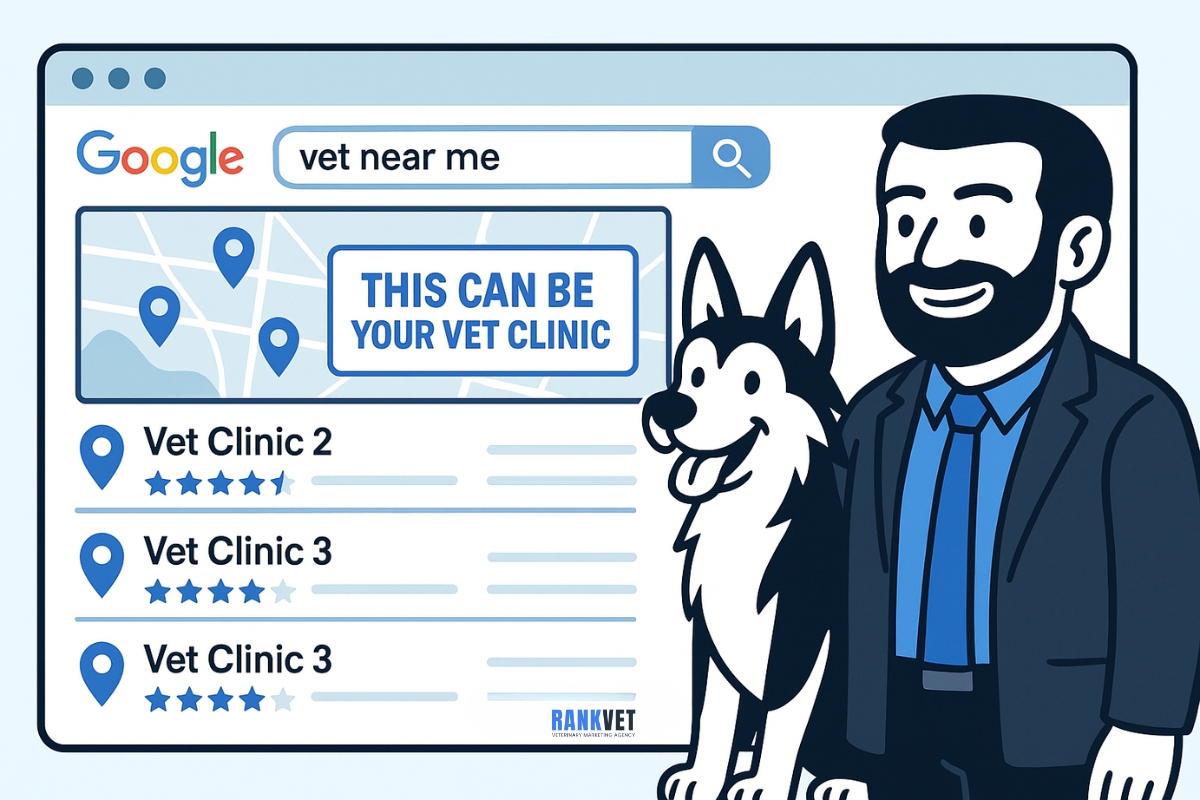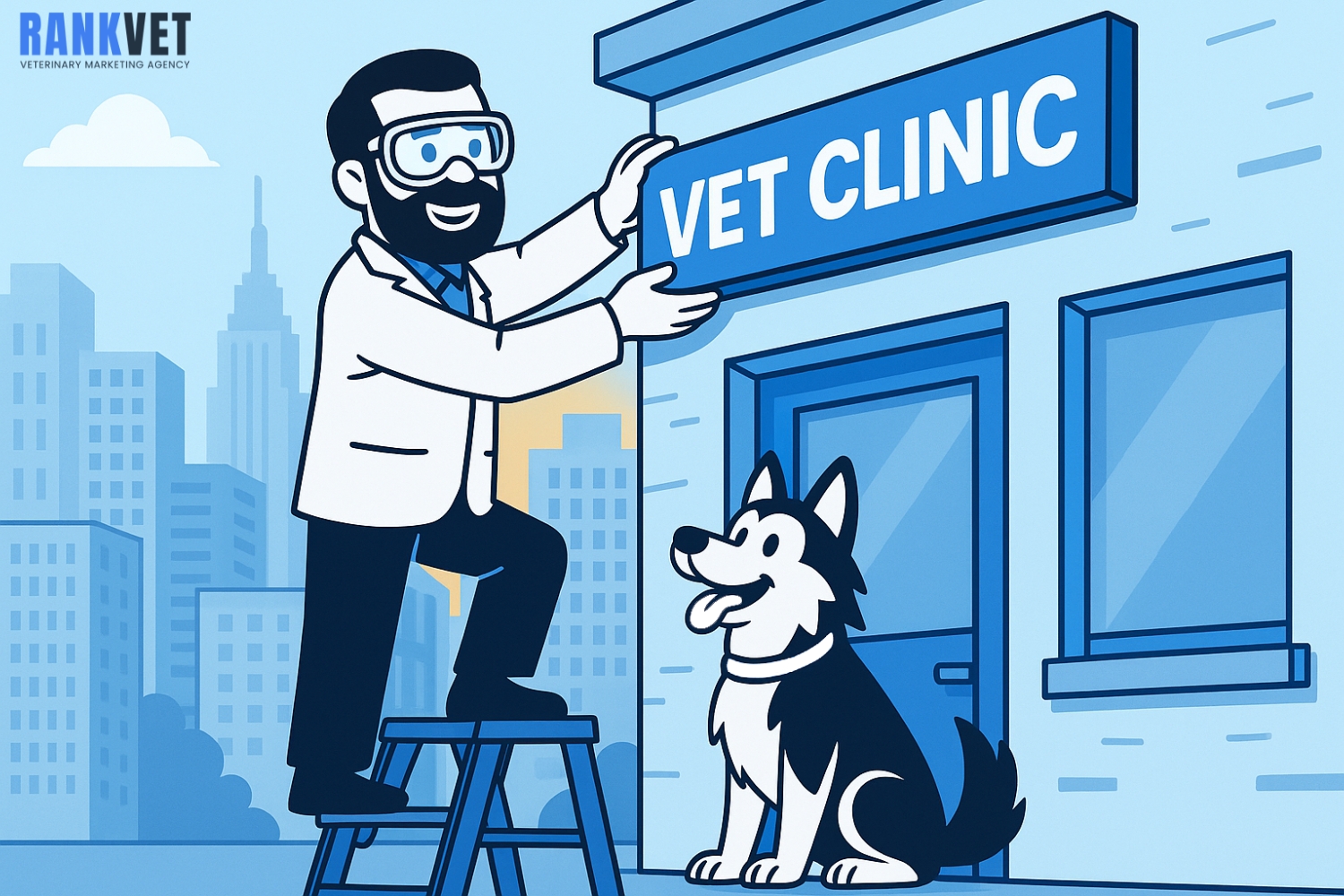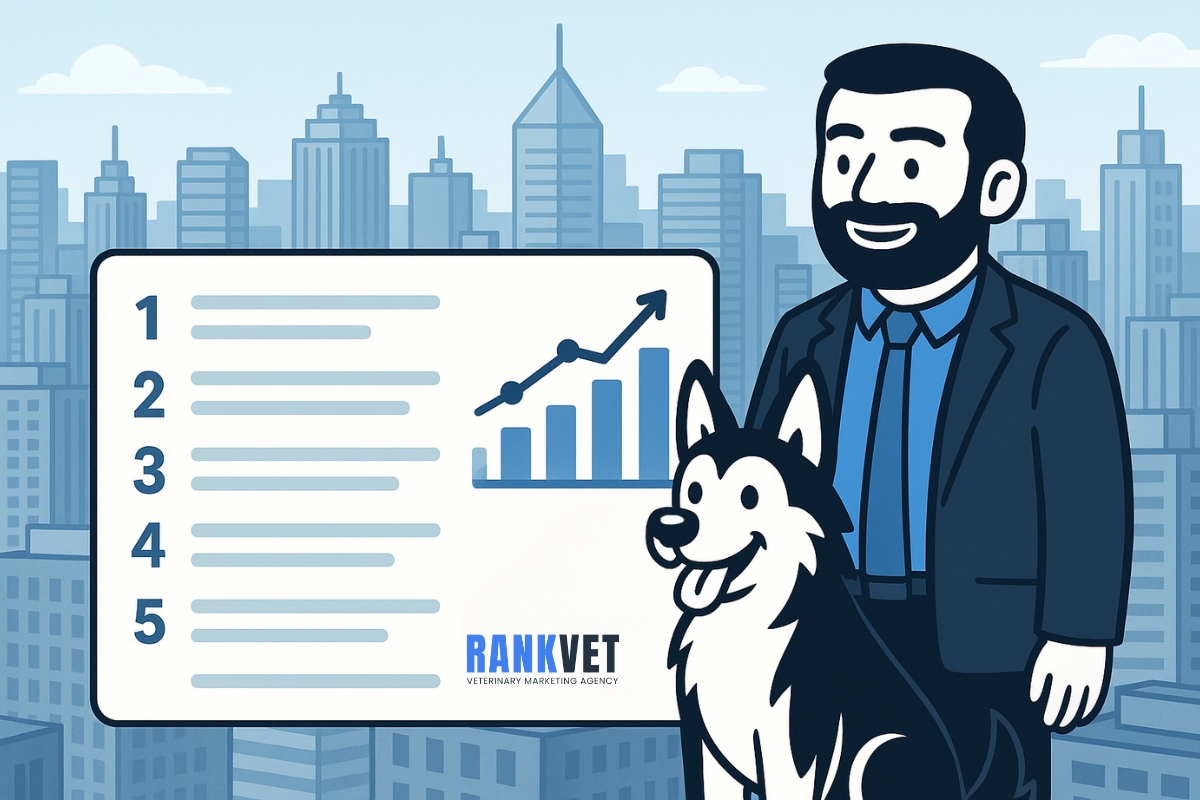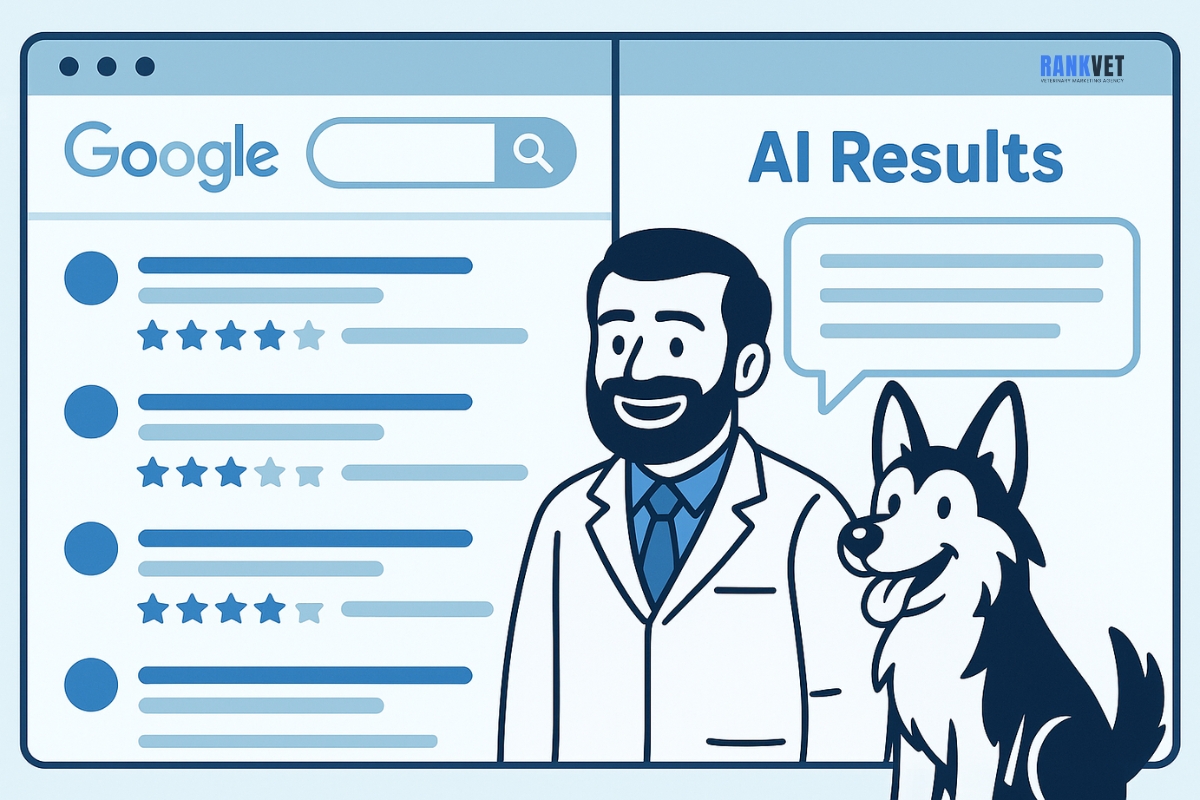Local search has never been more competitive. Whether you run a single storefront, a veterinary clinic, or a service area business, showing up in Google’s coveted three-pack drives the lion’s share of calls, website visits, and walk-ins. Below is an in-depth, step-by-step guide to help you outrank bigger brands and claim one of those limited spots.
If you need support, RankVet is a veterinary marketing agency built by a vet, for vets – specializing in local SEO and digital growth. Schedule a free consultation and let’s map out your veterinary SEO strategy together.
Understand How Google Ranks Local Results
Google decides which businesses appear in the local pack by weighing three primary signals: relevance, proximity, and prominence. Relevance measures how closely your business information and on-page content match the searcher’s intent. Proximity factors in the physical distance between the searcher and your address (or service area centroid). Prominence looks at the authority your brand has earned online – everything from review velocity and quality to backlinks and press mentions counts.
To win, you need to influence all three signals simultaneously. For example, a veterinary clinic can’t move its building closer to every searcher, but it can improve perceived proximity through service-area pages, localized schema, and consistent NAP (name, address, phone) data across directories. By balancing these levers, even a brand new practice can leapfrog long-established competitors that ignore local SEO hygiene.
Related article: Local SEO 101: How to Get Your Veterinary Clinic to the Top of Google (Maps and All!)
Relevance, Proximity, Prominence – A Deeper Dive
Relevance hinges on keyword placement and user intent matching. Proximity depends on your listed address, but also on geo-contextual cues like embedded Google Maps pins and neighborhood names in content. Prominence grows from authoritative backlinks, consistent citations, high-scoring reviews, and real-world visibility signals such as local press coverage. The sweet spot is where all three overlap – a business that is near the searcher, perfectly matches the query, and has undeniable authority. Craft your strategy to reinforce that overlap on every channel.
Optimize Your Google Business Profile Like a Pro
Your Google Business Profile (GBP) is the single most important local SEO asset. Fill out every available field – categories, services, products, attributes, and Q&A. Use high-resolution photos and short geotagged videos to show off your location, staff, and specialties. Post weekly updates that blend offers with educational snippets.
Critical for 2025: embrace new GBP features such as “Service Highlights,” “Appointment Links,” and “Profile Themes.” Service Highlights let you showcase unique selling points (for a vet clinic, think “24-Hour Emergency Care” or “Fear-Free Certified Staff”). Appointment Links integrate your booking platform directly into search results, adding convenience that Google rewards. Profile Themes, currently in beta, allow branding tweaks that make your listing stand out visually and signal freshness to Google’s algorithm.
Power Users Leverage GBP Insights for Continual Improvement
Inside your GBP dashboard, the Insights tab reveals how customers find you – discovery versus direct searches, map views versus search views, and the actions they take next. Export this data monthly, compare it with GSC (Google Search Console) queries, and update your listing to close content gaps. If “cat dental cleaning” searches spike, add that service as a Product with a price range. Aligning real-time insights with listing content tells Google your profile is active and relevant, boosting local pack potential.
Build a Wall of Consistent Citations and Hyperlocal Links
Citations are online mentions of your NAP across directories, industry lists, and social profiles. Consistency fuels trust – even a stray suite number variation can erode Google’s confidence. Start with the “big four” (Google, Bing, Apple Maps, Facebook) before expanding to industry-specific directories (VetRatingz, AVMA listings, or for other niches, sector-focused portals).
Hyperlocal links from neighborhood associations, local newspapers, and community blogs act as votes of confidence for both prominence and proximity. Sponsor a local 10K, guest post on the city’s chamber of commerce site, or provide expert quotes to regional journalists. Each link establishes you as a legitimate community member and pushes your brand’s authority beyond the confines of basic directory listings.
The Citation Cleanup Playbook
- Step one: audit your existing citations using tools like Whitespark or BrightLocal to surface inconsistencies.
- Step two: claim and correct erroneous listings manually or via a cleanup service.
- Step three: build new citations in batches, prioritizing high-authority domains.
Pair each submission with a unique paragraph about your business to avoid duplicate-content issues. Over time, track citation indexation in Google and Bing with site: queries to ensure they are being counted.
Master Review Generation and Reputation Signals
Reviews are the most tangible form of social proof Google can evaluate. A steady cadence of recent, keyword-rich, four- and five-star reviews signals high relevance and user satisfaction. Implement an automated post-visit email or SMS that asks happy customers to leave feedback, but ensure you follow Google’s review policies – no incentives or gating.
Respond to every review within 48 hours. Thoughtful responses demonstrate active management, improve buyer trust, and can even help long-tail ranking when you echo service keywords naturally. Encourage reviewers to upload photos – images increase engagement, and Google’s image recognition now parses those visuals to confirm context.
Turning Negative Reviews into Ranking Assets
Nobody enjoys criticism, but a well-handled negative review can actually boost your local pack credibility. Apologize sincerely, state the corrective action, and invite the reviewer to continue the conversation offline. Prospective clients see a proactive owner, and Google registers ongoing engagement. Over several months, the presence of balanced reviews – mostly positive, a few resolved negatives – looks authentic, which reinforces both prominence and relevance metrics.
Deploy Technical and On-Page SEO for Local Dominance
Your website remains the foundation of all local SEO efforts. Start with ultra-fast Core Web Vitals and mobile-first design – slow or unusable pages crack your ranking potential. Embed a dynamic Google Map showing your exact location, use city-plus-service keywords in H1, H2, and meta tags, and mark up every service page with LocalBusiness and Service schema.
Create dedicated city or neighborhood landing pages only when you truly serve those areas, and personalize each page with unique testimonials, driving directions, and hyperlocal landmarks. Overuse of templated pages can lead to thin content penalties. Instead, deepen each page with 1,000+ words describing local partnerships, before-and-after case studies, or community involvement stories.
Advanced Schema and AI-Driven Content Hubs
In 2025, schema variations like “GeoCoordinates,” “HasMap,” and “VirtualLocation” give Google precise context about where and how you operate. Pair this with AI-generated but human-edited content hubs that answer micro-intent queries (“best cat vet near South Park”), and interlink them to core service pages. This semantic web of authority boosts topical relevance and nudges Google toward featuring your business in more three-packs for long-tail searches.
Track, Test, and Evolve – The Continuous Improvement Loop
Local SEO is not a one-and-done activity. Set up a measurement stack that includes Google Analytics 4, Google Search Console, GBP Insights, and call tracking. Define KPIs such as map impressions, direction requests, phone calls, and booked appointments. Review trends monthly and isolate which optimizations moved the needle.
A/B test GBP cover photos, review-request timing, and schema enhancements. Document every change in a living spreadsheet so you can correlate actions with results. When rankings plateau, run a competitive gap analysis: examine top three-pack winners for schema types, backlink sources, and content clusters you lack. Close those gaps in the next sprint. Continuous iteration not only solidifies your spot in the current three-pack but future-proofs your visibility against algorithm tweaks.
Setting Realistic Timeframes and Expectations
For a brand new listing in a mid-sized city, cracking the three-pack can take three to six months if you tick every optimization box. In ultra-competitive metros, expect nine to twelve months of disciplined work. Share these timelines with stakeholders up front to manage expectations. Track short-term leading indicators (impressions, click-through rate) alongside lagging indicators (calls, revenue) so the team sees progress long before the needle moves on profit.
Master these pillars – algorithm fundamentals, GBP optimization, citation integrity, review velocity, technical excellence, and relentless measurement – and you will position your business to dominate the Google local three-pack not just today but for years to come.
How long does it take to rank in Google’s local 3-pack?
With a well-executed strategy most single-location businesses see measurable movement in 3-6 months, while highly competitive metros can take 9-12 months.
What is the difference between a Google Business Profile and a Google Maps listing?
Your Google Business Profile is the dashboard where you manage hours, photos, services and posts. The Google Maps listing is the public-facing result that searchers see; it pulls data directly from your profile.
Do customer reviews really impact 3-pack rankings?
Yes – review volume, recency and keyword relevance all feed Google’s prominence and trust signals, making reviews one of the strongest local ranking factors.
How many citations do I need to outrank competitors?
Quality beats quantity. Secure consistent NAP citations on the top industry and local directories, then focus on authoritative hyperlocal links from newspapers, chambers of commerce and community sites.
Will changing my business address hurt my local rankings?
An address change can cause temporary volatility. Mitigate it by updating your Google Business Profile first, then correcting all citations and adding an on-site location-change notice until Google fully processes the new data.





